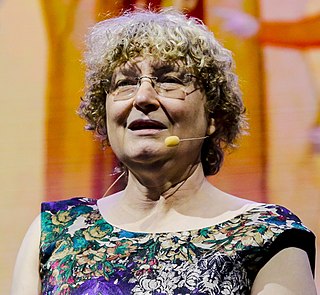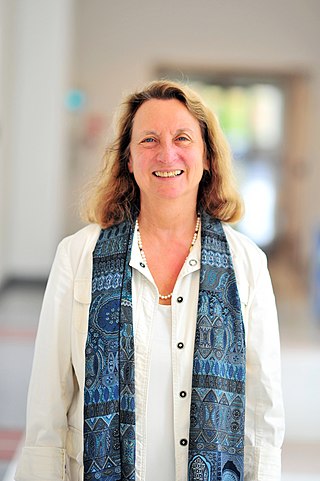Related Research Articles

Baroness Ingrid Daubechies is a Belgian-American physicist and mathematician. She is best known for her work with wavelets in image compression.

Charles Elachi is a Lebanese-American professor (emeritus) of electrical engineering and planetary science at the California Institute of Technology (Caltech). From 2001 to 2016 he was the 8th director of the Jet Propulsion Laboratory and vice president of Caltech.
The helicon double-layer thruster is a prototype electric spacecraft propulsion. It was created by Australian scientist Christine Charles, based on a technology invented by Professor Rod Boswell, both of the Australian National University.

Claudia Joan Alexander was a Canadian-born American research scientist specializing in geophysics and planetary science. She worked for the United States Geological Survey and NASA's Jet Propulsion Laboratory. She was the last project manager of NASA's Galileo mission to Jupiter and until the time of her death had served as project manager and scientist of NASA's role in the European-led Rosetta mission to study Comet Churyumov–Gerasimenko.
Edgar Y. Choueiri is a Lebanese American plasma physicist and previously president of the Lebanese Academy of Sciences. He is best known for clarifying the role of plasma instabilities in spacecraft electric thrusters, for conceiving and developing new spacecraft propulsion concepts and, more recently, for his work on 3D audio.

Genevieve Bell is the Vice-Chancellor of the Australian National University and an Australian cultural anthropologist. She is best known for her work at the intersection of cultural practice research and technological development, and for being an industry pioneer of the user experience field. Bell was the inaugural director of the Autonomy, Agency and Assurance Innovation Institute (3Ai), which was co-founded by the Australian National University (ANU) and CSIRO’s Data61, and a Distinguished Professor of the ANU College of Engineering, Computing and Cybernetics. From 2021 to December 2023, she was the inaugural Director of the new ANU School of Cybernetics. She also holds the university's Florence Violet McKenzie Chair, and is the first SRI International Engelbart Distinguished Fellow. Bell is also a Senior Fellow and Vice President at Intel. She is widely published, and holds 13 patents.
Roderick William Boswell AM FAA FTSE is an Australian physicist. He is a professor at the Australian National University in Canberra, in the Space Plasma, Power and Propulsion group of the Plasma Research Laboratory. He invented a technology which become the basis for the development of a new type of rocket thruster, the Helicon Double Layer Thruster: the ongoing development of the Australian Plasma Thruster is supported by the European Space Agency.

Margaret Galland Kivelson is an American space physicist, planetary scientist, and distinguished professor emerita of space physics at the University of California, Los Angeles. From 2010 to the present, concurrent with her appointment at UCLA, Kivelson has been a research scientist and scholar at the University of Michigan. Her primary research interests include the magnetospheres of Earth, Jupiter, and Saturn.
Bimla Buti was an Indian physicist who specialized in the field of plasma physics. She was the first Indian woman Physicist Fellow of Indian National Science Academy(INSA). In 1994, she was awarded INSA-Vainu Bappu Award.
Vinod Krishan, is an Indian physicist, a Senior Professor and dean of sciences at the Indian Institute of Astrophysics, Bangalore. She is involved in teaching and research in Plasma Physics. She is a Fellow of the National Academy of Sciences, India and the 1991 recipient of the Vikram Sarabhai Award for Space Sciences.

Sir Steven Charles Cowley is a British theoretical physicist and international authority on nuclear fusion and astrophysical plasmas. He has served as director of the United States Department of Energy (DOE) Princeton Plasma Physics Laboratory (PPPL) since 1 July 2018. Previously he served as president of Corpus Christi College, Oxford, since October 2016. and head of the EURATOM / CCFE Fusion Association and chief executive officer of the United Kingdom Atomic Energy Authority (UKAEA).
Mahananda (Nanda) Dasgupta FAA, FAIP, FAPS is an experimental physicist at the Heavy Ion Accelerator Facility in the Department of Nuclear Physics of the Australian National University, whose work focuses on accelerator-based nuclear fusion and fission.

Elaine Surick Oran is an American physical scientist and is considered a world authority on numerical methods for large-scale simulation of physical systems. She has pioneered computational technology to solve complex reactive flow problems, unifying concepts from science, mathematics, engineering, and computer science in a new methodology. An incredibly diverse range of phenomena can be modeled and better understood using her techniques for numerical simulation of fluid flows, ranging from the tightly grouped movements of fish in Earth's oceans to the explosions of far-flung supernovae in space. Her work has contributed significantly to the advancement of the engineering profession.

Emily A. Carter is the Gerhard R. Andlinger Professor in Energy and the Environment and a professor of Mechanical and Aerospace Engineering (MAE), the Andlinger Center for Energy and the Environment (ACEE), and Applied and Computational Mathematics at Princeton University. She is also a member of the executive management team at the Princeton Plasma Physics Laboratory (PPPL), serving as Senior Strategic Advisor and Associate Laboratory Director for Applied Materials and Sustainability Sciences.
Marcela Bilek is a Professor of Applied Physics and Surface Engineering at the University of Sydney, Australia. Her research interests focus on the use of plasma related methods to synthesise thin film materials and modify surfaces and interfaces. She was named Fellow of the American Physical Society in 2012 and Fellow of the Institute of Electrical and Electronics Engineers (IEEE) in 2015 for contributions to the science and application of plasma processes for materials modification and synthesis.

Donna Theo Strickland is a Canadian optical physicist and pioneer in the field of pulsed lasers. She was awarded the Nobel Prize in Physics in 2018, together with Gérard Mourou, for the practical implementation of chirped pulse amplification. She is a professor at the University of Waterloo in Ontario, Canada.
Roy Walter Gould was an American electrical engineer and physicist who specialized in plasma physics. In 1959, he was the first to describe electrostatic waves that were propagating at the boundary of a magnetized plasma column, now commonly known as Trivelpiece–Gould modes.

Subrata Roy is an Indian-born American inventor, educator, and scientist known for his work in plasma-based flow control and plasma-based self-sterilizing technology. He is a professor of Mechanical and Aerospace Engineering at the University of Florida and the founding director of the Applied Physics Research Group at the University of Florida.
Merav Opher is a professor of astronomy at Boston University known for her work on the heliosphere, the cocoon formed by the wind emanated from the Sun as it travels in the Galaxy. In 2021 she was named a William Bentinck-Smith Fellow at the Harvard Radcliffe Institute.
Carolyn C. Kuranz is an American plasma physicist whose research involves the use of high-powered lasers at the National Ignition Facility both to help develop inertial confinement fusion and to study how matter behaves in conditions similar to those in shock waves in astrophysics. She is an associate professor at the University of Michigan, in the Department of Nuclear Engineering and Radiological Sciences.
References
- 1 2 3 4 5 RSPE, Director. "Professor Christine Charles -". RSPE - ANU. Retrieved 6 August 2018.
- 1 2 "Professor Christine Charles". Australian Academy of Science. Retrieved 6 August 2018.
- ↑ McPhillips, Amy. "Local Leaders – Dr Christine Charles (ANU's Space Plasma, Power and Propulsion Laboratory)". The RiotACT. Retrieved 6 August 2018.
- 1 2 "Prof. Christine Charles and the Cubesat Team at ANU". Ideas Hoist. 2 August 2016. Retrieved 6 August 2018.
- 1 2 3 4 "Christine Charles". Loop. Retrieved 6 August 2018.